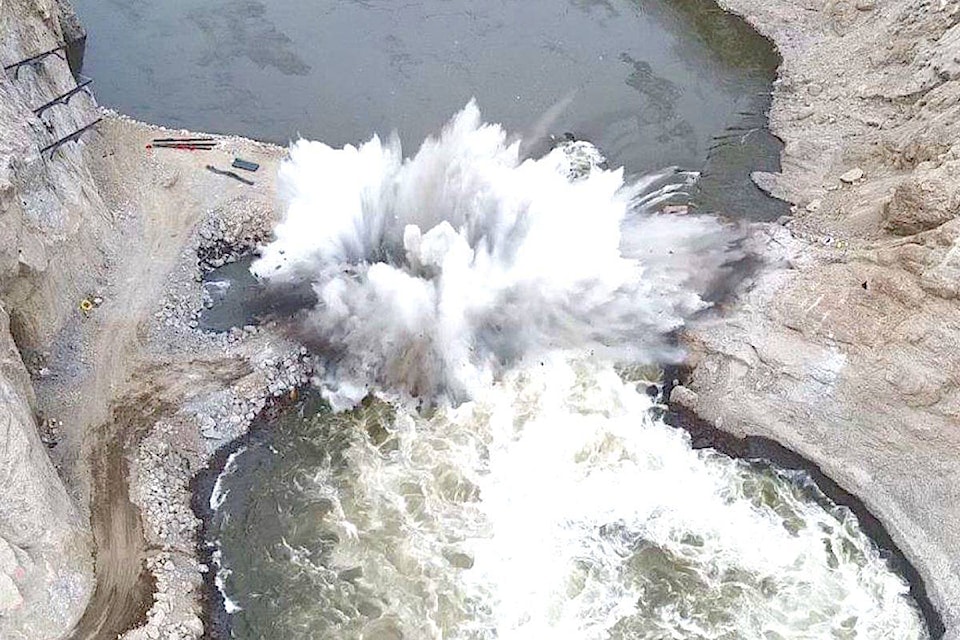They’ve been drilling and blasting boulders at the Big Bar landslide site in a race against time.
“The COVID-19 outbreak has not caused significant delays to the work at the Big Bar landslide,” reads the update of March 25 from Department of Fisheries and Oceans.
Peter Kiewit Sons, the main contractor, is taking precautions at the remote site northwest of Kamloops, including restricting site access to limit any health and safety risk to workers.
The pressure is on in the coming weeks because the work has to be done when the water levels are low. Since mid-January, they’ve made steady progress removing the blockage to fish passage, despite challenging weather and access issues.
#BigBarLandslide Update: Blasting and removal of in-river boulders well underway. Learn more: http://t.co/FQVnqipW8s pic.twitter.com/c6yIPBgQ4R
— DFO Pacific (@DFO_Pacific) March 13, 2020
But there may be a new obstacle.
“Although Kiewit has been successful in meeting the winter work objectives, removing large boulders and debris, recent modelling done at low water shows that a mass of slide debris situated elsewhere in the river will cause heavy flows at high water, stopping fish passage,” said DFO in the update.
Sto:lo Tribal Council Grand Chief Ken Malloway, who sat on the First Nations panel for Big Bar, said he appreciated getting the update about the most recent drilling and blasting, but said more frequent updates would be even better.
The 2020 impacts on Early Stuart sockeye and chinook from the slide blockage are a huge concern.
“I know they’re going to do as much as they can before the high water comes,” Malloway said.
But he’s a little concerned about the “mass of slide debris situated elsewhere in the river,” that was mentioned in the report that could threaten to block fish this spring.
“I hope they’re able to clear that slide quickly if it looks like it’s going to be a problem,” he said.
READ MORE: Long-awaited blasting started again in February
DFO reps reported that they hope to build a “nature-like” fishway, a pneumatic fish lift system, and a trap-and-transport option to scoop up salmon below the slide and release them up river.
Contingency planning for the enhancement of stocks returning to the upper Fraser watershed is also ongoing. A monitoring program throughout the salmon migration period is meant to gather as much information as possible and to aid the implementation of the contingency plans.
DFO project staff met with Chief Roy Fletcher and Coordinator Dennis Fletcher from the High Bar First Nation (HBFN) on March 9, and with Chief Patrick Harry and Coordinator Catlin Duncan from the Stswecem’c Xgat’tem First Nation (SXFN) on March 11 to review the proposed contingency plans.
The initial Big Bar slide, which was discovered last June, severely restricted fisheries and impacted communities reliant on fish. That triggered a joint effort in July 2019 by federal and provincial officials and First Nations to clear the obstruction.
READ MORE: First Nations leaders calling for swift action at Big Bar
The response to the Big Bar landslide has been collaborative, and teams have been working with communities to ensure they remain an integral part of the planning, operations, and decision-making process. Sustained efforts will be required, possibly into years ahead, to reduce the impact of the landslide on future salmon stocks, according to DFO.
For more see DFO’s Big Bar Landslide Response webpage or the Province of BC’s Big Bar Landslide Incident webpage.
Do you have something to add to this story, or something else we should report on? Email:
jfeinberg@theprogress.com
@CHWKjourno
Like us on Facebook and follow us on Twitter.
